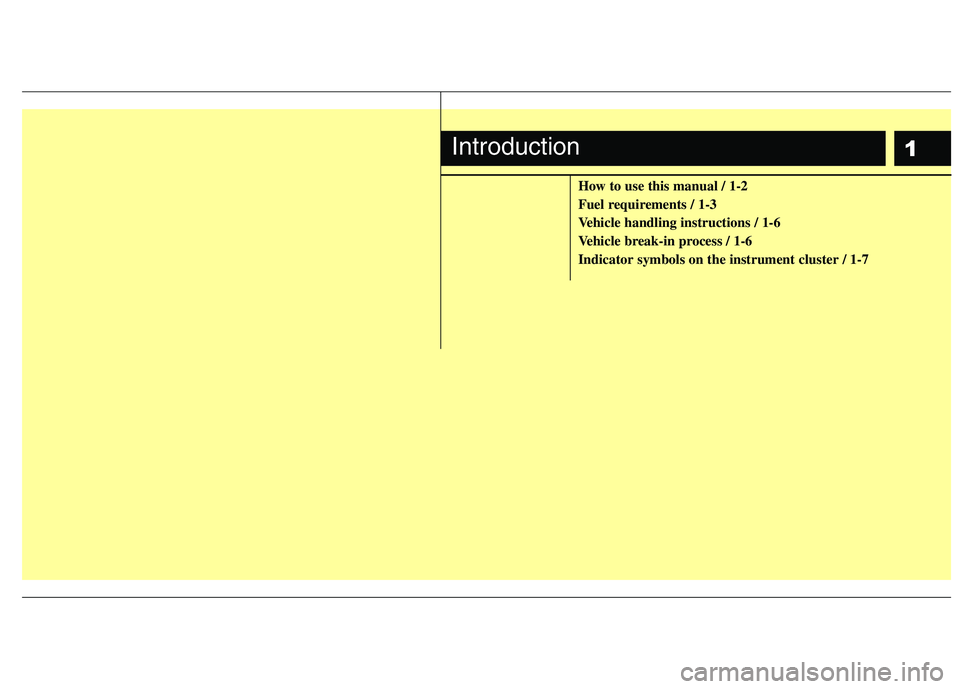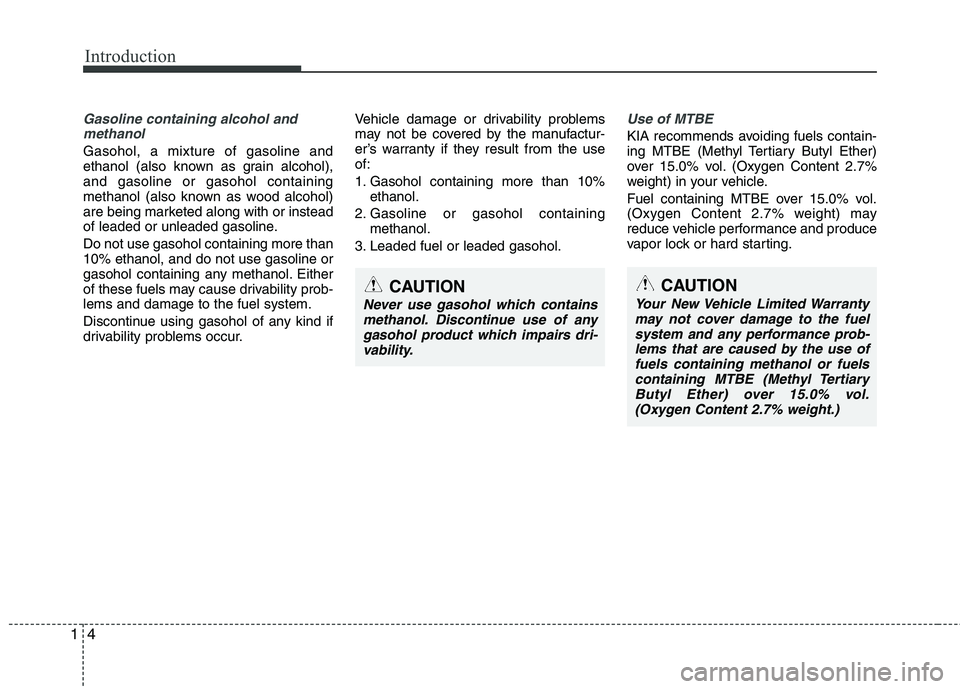2010 KIA SORENTO fuel
[x] Cancel search: fuelPage 4 of 399

1
How to use this manual / 1-2
Fuel requirements / 1-3
Vehicle handling instructions / 1-6
Vehicle break-in process / 1-6Indicator symbols on the instrument cluster / 1-7
Introduction
Page 6 of 399

13
Introduction
Gasoline engine
Unleaded
For Europe
For the optimal vehicle performance, we
recommend you to use unleaded gaso-
line with an octane rating of RON(Research Octane Number) 95 / AKI
(Anti Knock Index) 91 or higher.
You may use unleaded gasoline with an
octane rating of RON 91~94 / AKI 87~90
but it may result in slight performance
reduction of the vehicle.
Except Europe
Your new KIA vehicle is designed to use
only unleaded fuel having an Octane
Rating of RON (Research Octane
Number) 91 / AKI (Anti-Knock Index) 87
or higher.
Your new vehicle is designed to obtain
maximum performance with UNLEADED
FUEL, as well as minimize exhaust emis-
sions and spark plug fouling.
Leaded (if equipped)
For some countries, your vehicle is
designed to use leaded gasoline. When
you are going to use leaded gasoline,
ask an authorized KIA dealer whether
leaded gasoline in your vehicle is avail-
able or not. Octane Rating of leaded gasoline is
same with unleaded one.
FUEL REQUIREMENTS
WARNING
• Do not "top off" after the nozzle automatically shuts off when refueling.
Always check that the fuel cap is installed securely to prevent fuel
spillage in the event of an acci-dent.CAUTION
NEVER USE LEADED FUEL. The
use of leaded fuel is detrimental to
the catalytic converter and willdamage the engine control sys-tem’s oxygen sensor and affect emission control.
Never add any fuel system cleaningagents to the fuel tank other thanwhat has been specified. (Consultan authorized KIA dealer for
details.)
Page 7 of 399

Introduction
4
1
Gasoline containing alcohol and
methanol
Gasohol, a mixture of gasoline and
ethanol (also known as grain alcohol),and gasoline or gasohol containing
methanol (also known as wood alcohol)
are being marketed along with or instead
of leaded or unleaded gasoline. Do not use gasohol containing more than 10% ethanol, and do not use gasoline or
gasohol containing any methanol. Either
of these fuels may cause drivability prob-lems and damage to the fuel system.
Discontinue using gasohol of any kind if
drivability problems occur. Vehicle damage or drivability problems
may not be covered by the manufactur-
er’s warranty if they result from the useof:
1. Gasohol containing more than 10%
ethanol.
2. Gasoline or gasohol containing methanol.
3. Leaded fuel or leaded gasohol.
Use of MTBE
KIA recommends avoiding fuels contain-
ing MTBE (Methyl Tertiary Butyl Ether)
over 15.0% vol. (Oxygen Content 2.7%
weight) in your vehicle.
Fuel containing MTBE over 15.0% vol.
(Oxygen Content 2.7% weight) may
reduce vehicle performance and produce
vapor lock or hard starting.
CAUTION
Your New Vehicle Limited Warranty may not cover damage to the fuelsystem and any performance prob- lems that are caused by the use of
fuels containing methanol or fuelscontaining MTBE (Methyl TertiaryButyl Ether) over 15.0% vol. (Oxygen Content 2.7% weight.)
CAUTION
Never use gasohol which contains
methanol. Discontinue use of any gasohol product which impairs dri- vability.
Page 8 of 399

15
Introduction
Do not use methanol
Fuels containing methanol (wood alco-
hol) should not be used in your vehicle.
This type of fuel can reduce vehicle per-
formance and damage components ofthe fuel system.
Gasolines for cleaner air
To help contribute to cleaner air, KIA rec-
ommends that you use gasolines treated
with detergent additives, which help pre-
vent deposit formation in the engine.
These gasolines will help the engine run
cleaner and enhance performance of theEmission Control System.
Operation in foreign countries
If you are going to drive your vehicle in
another country, be sure to:
Observe all regulations regarding reg-istration and insurance.
Determine that acceptable fuel is avail- able. Diesel engine
Diesel fuel
Diesel engine must be operated only on
commercially available diesel fuel that
complies with EN 590 or comparable
standard. (EN stands for "European
Norm"). Do not use marine diesel fuel,
heating oils, or non-approved fuel addi-
tives, as this will increase wear andcause damage to the engine and fuel
system. The use of non-approved fuels
and / or fuel additives will result in a limi-
tation of your warranty rights.
Diesel fuel of above cetane 52 is used in
your vehicle. If two types of diesel fuel
are available, use summer or winter fuel
properly according to the following tem-
perature conditions.
Above -5°C (23°F) ... Summer type diesel
fuel.
Winter type diesel fuel.
Watch the fuel level in the tank very care-
fully : If the engine stops through fuel fail-
ure, the circuits must be completely
purged to restart.
CAUTION
Do not let any gasoline or water enter the tank. This would make it
necessary to drain it out and to bleed the lines to avoid jammingthe injection pump and damagingthe engine.
In winter, in order to cut down incidents due to freezing, paraffinoil may be added to the fuel if the temperature drops below -10°C
(14°F). Never use more than 20% paraffin oil.
CAUTION - Diesel Fuel
It is recommended to use the regu-
lated automotive diesel fuel for
diesel vehicle equipped with theDPF system.
If you use diesel fuel including highsulfur (more than 50 ppm sulfur) and unspecified additives, it can
cause the DPF system to be dam-aged and white smoke can be emit- ted.
Page 9 of 399

Introduction
6
1
Biodiesel
Commercially supplied Diesel blends of no more than 7% biodiesel, commonly
known as "B7 Diesel" may be used in
your vehicle if Biodiesel meets EN 14214
or equivalent specifications. (EN stands
for "European Norm"). The use of biofu-
els exceeding 7% made from rapeseed
methyl ester (RME), fatty acid methyl
ester (FAME), vegetable oil methyl ester
(VME) etc. or mixing diesel exceeding7% with biodiesel will cause increased
wear or damage to the engine and fuel
system. Repair or replacement of worn ordamaged components due to the use of
non approved fuels will not be covered by
the manufactures warranty. As with other vehicles of this type, failure
to operate this vehicle correctly mayresult in loss of control, an accident or
vehicle rollover.
Specific design characteristics (higher
ground clearance, track, etc.) give this
vehicle a higher center of gravity than
other types of vehicles. In other words
they are not designed for cornering at the
same speeds as conventional 2-wheel
drive vehicles. Avoid sharp turns or
abrupt maneuvers. Again, failure to oper-
ate this vehicle correctly may result in
loss of control, an accident or vehicle
rollover.
Be sure to read the “Reducing
the risk of a rollover” driving guide-
lines, in section 5 of this manual. No special break-in period is needed. By
following a few simple precautions for the
first 1,000 km (600 miles) you may add to
the performance, economy and life of
your vehicle.
Do not race the engine.
While driving, keep your engine speed
(rpm, or revolutions per minute) within
3,000 rpm.
Do not maintain a single speed for long periods of time, either fast or slow.
Varying engine speed is needed to
properly break-in the engine.
Avoid hard stops, except in emergen- cies, to allow the brakes to seat prop-
erly.
Don't let the engine idle longer than 3 minutes at one time.
Don't tow a trailer during the first 2,000
km (1,200 miles) of operation.
VEHICLE BREAK-IN PROCESS
VEHICLE HANDLING
INSTRUCTIONS
CAUTION
Never use any fuel, whether
diesel or B7 biodiesel or other-wise, that fails to meet the latestpetroleum industry specification.
Never use any fuel additives or treatments that are not recom-mended or approved by the vehi- cle manufacturer.
Page 10 of 399

17
Introduction
INDICATOR SYMBOLS ON THE INSTRUMENT CLUSTER
Seat belt warning light
Door/tailgate open position indicator*
Tailgate open warning light
High beam indicator
Light on indicator*
Turn signal indicator
Front fog light indicator*
ABS warning light
Parking brake & Brake fluid
warning light
Engine oil pressure warning light
4WD system warning light* 4WD LOCK indicator*
Malfunction indicator*
Air bag warning light
Cruise SET indicator*
Low fuel level warning light
Shift pattern indicator*
DBC indicator*
❈ For more detailed explanations, refer to “Instrument cluster” in section 4.
Charging system warning light
Low windshield washer fluid level
warning light*
Door ajar warning light
Overspeed warning light*
120km/h
Key out warning light*KEY
OUT
* if equipped
Glow indicator (Diesel only)
Fuel filter warning light (Diesel only)
Cruise indicator*
Rear fog light indicator*
ESP indicator*
ESP OFF indicator*
Immobilizer indicator*
Low tire pressure telltale*/
TPMS (Tire Pressure MonitoringSystem) malfunction indicator*
Low tire pressure position telltale*
Page 12 of 399

Your vehicle at a glance
2
2
INTERIOR OVERVIEW
1. Door lock/unlock button ....................4-14
2. Outside rearview mirror folding
button*...............................................4-38
3. Outside rearview mirror control switch ................................................4-37
4. Central door lock switch* ..................4-14
5. Power window lock button* ...............4-23
6. Power window switches ....................4-20
7. Fuel filler lid release button...............4-26
8. Head lamp leveling device*...............4-67
9. 4WD lock button* ..............................5-23
10. ESP OFF button* ...........................5-35
11. Headlight washer button*................4-68
12. DBC button* ....................................5-38
13. Instrument panel illumination control switch*.............................................4-41
14. Steering wheel tilt control* ..............4-34
15. Steering wheel ................................4-33
16. Fuse box .........................................7-51
17. Hood release lever ..........................4-24
18. Seat...................................................3-2
19. Air vent ............................................4-78
* : if equipped
OXM019001L
Page 14 of 399

Your vehicle at a glance
4
2
ENGINE COMPARTMENT
OXM019003
1. Engine coolant reservoir ..................7-25
2. Engine oil filler cap ..........................7-24
3. Fuel filter ..........................................7-31
4. Brake fluid reservoir.........................7-28
5. Air cleaner .......................................7-32
6. Fuse box ..........................................7-51
7. Negative battery terminal ................7-39
8. Positive battery terminal ..................7-39
9. Radiator cap ....................................7-27
10. Engine oil dipstick ..........................7-24
11. Power steering fluid reservoir ........7-29
12. Windshield washer fluid reservoir ..7-30
* The actual engine room in the vehicle may differ from the illustration.